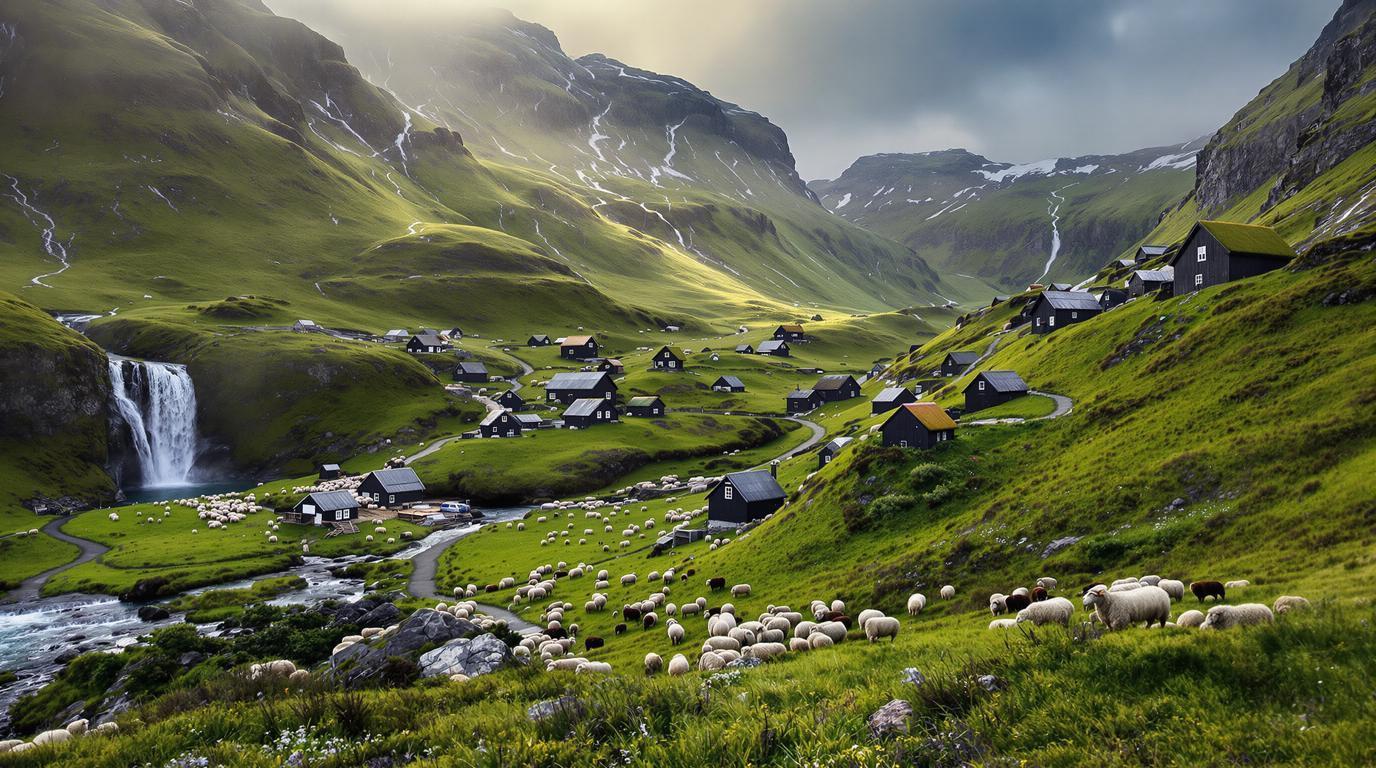The wild, otherworldly landscape of Streymoy emerges from the North Atlantic like a mirage of another time. This largest island in the Faroe Islands archipelago might technically belong to Denmark, but it exists in a realm all its own – where sheer cliffs plunge into churning seas and villages with grass-roofed houses seem plucked from folklore.
The island where sheep outnumber people
With just 24,000 residents and over 70,000 sheep roaming its hills, Streymoy embodies the Faroese connection to nature. These woolly inhabitants create the distinctive landscape of closely-cropped emerald slopes that cascade dramatically into the sea. The island’s name literally translates to “Stream Island,” referencing the countless waterfalls that streak down its cliffs after rainfall.
Tórshavn: Europe’s tiniest capital with outsized charm
Streymoy hosts Tórshavn, the Faroese capital and one of the world’s smallest capital cities. Despite its size, this harbor town captivates with its historic Tinganes peninsula – where red-painted wooden buildings with turf roofs house government offices dating back to Viking parliamentary gatherings. Wandering its narrow lanes feels like stepping through the pages of a Nordic fairy tale.
“Our capital has existed since Viking times, but it still feels like a secret. Visitors are always surprised by how such a small place can hold so much history and culture,” shares Maria Olsen, a local tour guide.
Vestmanna bird cliffs: A wildlife spectacle like no other
The northwestern coast of Streymoy presents one of the Faroe Islands’ most spectacular natural attractions. Boat tours from the village of Vestmanna navigate through narrow sounds and into sea caves, where thousands of seabirds – including puffins, guillemots, and fulmars – create a cacophony of calls against towering 600-meter cliffs.
Saksun: The village that time forgot
Tucked within a natural amphitheater of mountains, the tiny settlement of Saksun surrounds a tidal lagoon that fills and empties with each cycle of the moon. The handful of black-tarred wooden houses with bright green turf roofs create one of the most photographed scenes in all the Faroe Islands. The 17th-century Dúvugarðar farmhouse, now a museum, offers a glimpse into traditional island life.
Engineering wonders beneath the waves
Streymoy connects to neighboring islands through remarkable subsea tunnels, including the Eysturoyartunnilin featuring the world’s first underwater roundabout. This engineering marvel, completed in 2020, includes an illuminated art installation that transforms a practical transit route into an otherworldly experience – much like other islands that blend natural beauty with human ingenuity.
A cuisine born from necessity and isolation
Faroese cuisine reflects centuries of preservation techniques developed to survive harsh North Atlantic winters. Traditional restaurants in Tórshavn serve skerpikjøt (wind-dried mutton) and ræst kjøt (fermented lamb) – flavors unique to this archipelago that developed in isolation, similar to how smaller islands often develop distinctive culinary traditions.
“Our food tells our story of survival. When you taste skerpikjøt, you’re tasting our history and the wind and weather of Streymoy,” explains Chef Poul Andrias Ziska of the acclaimed restaurant KOKS.
Where to stay: From grass-roofed cottages to boutique hotels
Accommodations range from traditional grass-roofed cottages to the stylish Hotel Føroyar in Tórshavn, built into a hillside with sweeping views of the capital and sea beyond. The remoteness has preserved authentic experiences unlike larger island destinations that struggle with overtourism.
Beyond predictable travel: Tjørnuvík’s hidden beach
The northernmost village on Streymoy, Tjørnuvík offers views of the sea stacks Risin og Kellingin (The Giant and the Witch) and a black sand beach where brave souls surf in the bracing Atlantic. Like other islands that maintain their character despite visitors, Tjørnuvík retains its working-village atmosphere.
Autonomous yet connected: The unique Faroese identity
While technically part of Denmark, the Faroe Islands maintain significant autonomy and a distinct cultural identity with their own language, flag, and traditions. This independent spirit mirrors other island communities that preserve traditional governance systems while adapting to modern times.
Streymoy embodies something increasingly rare in our hyperconnected world – a place where dramatic landscapes, ancient traditions, and modern life coexist in harmonious balance. Here, where the line between myth and reality blurs with each passing fog bank, travelers discover not just stunning vistas but a profound connection to nature and time itself.
